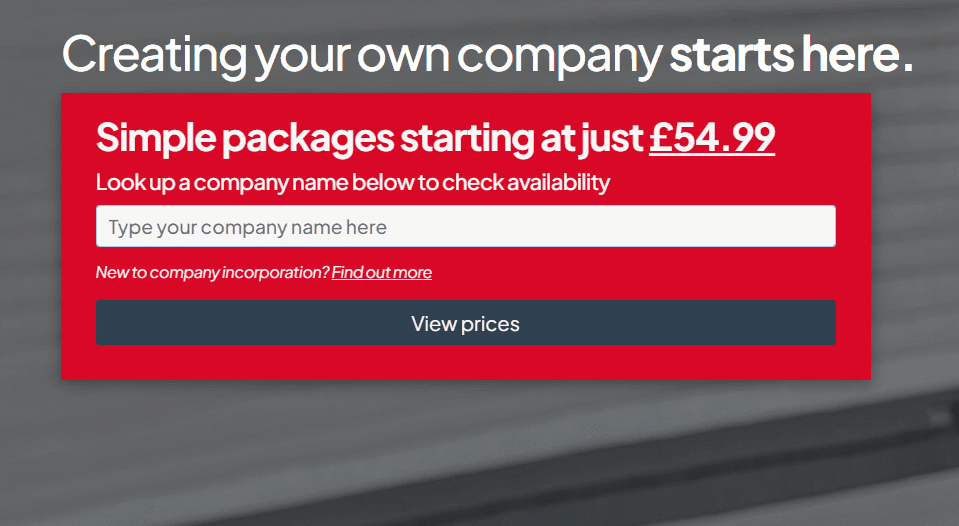Registering a company is actually rather straightforward. The time it takes is dependent on how Companies House receives your application.
You can register your company through the following ways:
- By post
- Using third-party software or using an agent
Submitting your application via post takes the longest. You will have to complete the IN01 form and post that to Companies House. But, please note that registering by post can take between 8-10 days and also costs £71 through Companies House.
Opting to register online will be more time efficient and convenient for you. It may be possible to submit the online application and also have the company registered all
within 24 -48 hours! It is important to consider when you submit the application, such as weekends or at the end of the working day, as it may take longer for Companies House to process the registration. If you need your company incorporated urgently, we recommend purchasing our
Same-Day Incorporation Service, which costs an additional £89 + VAT. You can see the full pricing page
here. After your registration has been processed, your new
limited company is ready to trade!
So, what is a limited Company and why might I want to set this up?
It is important to consider if setting up a private
limited company is suitable for you, as it can affect a number of factors such as the way tax is paid, protection of personal finances, adds credibility to your business etc. The
two types of limited companies that will be covered in this article is a company that is ‘limited by shares’ and a company ‘limited by guarantee’.
‘Limited by shares’
This is a common company structure for businesses that intend to make a profit. As the company is owned by shareholders (can be 1 or more), the profits can be distributed to the shareholders through dividends. With this company structure, the company is legally separate from the owners and so the company itself is responsible for any company debts. The shareholders, on the other hand, are only responsible for debts equivalent to the value of the shares. This type of company can raise capital by issuing shares, which is where the company sells a part of its ownerships to fund the company’s business operations.
‘Limited by guarantee’
These types of structure are suitable for ‘not for profit’ organisations like charities. Profits are not distributed to the members but instead the profits are reinvested back into the company. The Company is owned by guarantors through a fixed amount of money (guarantee), usually £1.00. Should the legal entity be wound up, the guarantors are limited to the amount that was guaranteed. This type of company does not have shares and so raises capital through donations, government grants or subscription/membership fees, depending on the company's principal activity.
What information is required to complete the application?
Having all the relevant information on hand will definitely assist you in completing the application with ease. The overview below discusses the information required.
- Selecting your Company name - On our software, you can check the company name availability by entering the desired name under the ‘Get started’ box on the homepage. Please click here to try it out!

- Company’s main principal activity- It is selected through SIC (standard industrial classification) codes that describe the company’s nature of business.
- Registered Office Address – Mail from HMRC + Companies House will be delivered here. Please note the address should in the same country the company was registered in and must be a physical address in the UK.
- Appoint a director – Minimum of 1 director is required.
- Company Secretary – This is optional for private limited company but can be the same as the appointed director.
- Shareholder/guarantor member details- Minimum of 1 member is required.
- People with significant control (PSC) – it can usually be members, but there are also conditions to be met in order to identify as a PSC.
How can we help and what package should I opt for?
We are here to help you incorporate your company seamlessly! After all, we do understand the how stressful this process can be. After you have opted for a formation package, we aim to respond to you as soon as we receive an update regarding the application’s status from Companies House. The great thing about our service is that this whole process can be completed during the working day, within 4 – 8 hours!
Our formation package costs £54.99+ VAT and includes the following:
- Ready to trade Limited Company
- Email copy of Certificate of Incorporation
- Email copy of Share Certificate
- HMRC UTR Number
- Web Authentication code
Please note that the Companies House filing fee of £50 is included in our package price! We do offer further add-on packages where you can add registered address (London Eastcheap, EC3) and also add business address (London Eastcheap, EC3). Please visit our pricing page
here to see more details on these add-ons.
What happens is my incorporation registration gets rejected?
There are a number of reasons why the application might be rejected, but this is normally an easy fix. Our team at Easy Digital will be able to work through the rejection with some follow-up information on how this can be rectified. Please visit our
article to learn about the requirements for incorporations and how you can avoid rejections.
My company is now trading... what next?
After you have incorporated your company with Companies House,
HMRC will be notified automatically and will send an important document to the registered address, detailing the company’s UTR (Unique Tax Reference) number. This 10-digit number is used to identify your company, so please keep it safe!
Using your UTR number, you will need to
set up a Government Gateway Business account for your company, which will allow you to access HMRC’s portal. Please note that this is separate to your personal Government Gateway account, which has a different UTR number. This is specifically used to submit your Self- Assessment tax returns.
Please follow this
link to set up an account. If you scroll down to Organisation accounts and select 'set up an account', you can then 'create sign in details'. Here you will be creating your User ID and Password that is used to access your Government Gateway account. Next, you will need to consider what additional services you would like to add to your Gateway account, such as Corporation Tax, VAT, PAYE etc.
Adding Corporation Tax service is important, so that you can manage your tax position with HMRC. To add Corporation Tax Service to your Government Gateway account, please click 'get online access to a tax, duty or scheme' from the business summary page and select Corporation Tax. Please then enter your UTR and the other required information. Your activation code will then be posted within 7+ working days. The letter with the code should assist you in activating the service through the written instructions. Following the steps aforementioned will help you submit your Corporation Tax Returns and pay any Corporation tax due easily. You can follow the same steps for adding VAT (if VAT registered) or PAYE (registered to run a payroll) if these services are applicable to your company. You can always add these additional services at a later time when they are applicable to you.
What are HMRC and Companies House’s filing obligations and deadlines?
HMRC expects Corporation Tax Return and IXBRL tagged full accounts every year. The full accounts include both the profit and loss (income) statement and the balance sheet. Corporation Tax Returns are expected to be filed 12 months after the end of the accounting period. Any Corporation Tax due is expected 9 months and 1 day after the end of the accounting period..
Companies House currently expect annual abridged accounts to be submitted, which is just the balance sheet. They also expect the confirmation statement to be filed on a yearly basis. The confirmation statement allows for your company to confirm that all company information is correct and up-to-date.
Please note that even if you decide to not trade straight away (dormant status), there are still filing obligations to be met by Companies House and HMRC. Once both entities have been informed of the company’s dormant status, Companies will still expect annual abridged accounts and confirmation statement to be filed.
We do offer a
Managed Filing service, if you prefer one of our Accounts Specialists to complete all the relevant filings to HMRC + Companies House. Your accounts specialist will require some supporting documents in order to complete the filings for you. This can either be the profit and loss statement and balance sheet, if you use book-keeping software or alternatively, if you record your income and expenses on an excel spreadsheet, that is also fine. You will be able to upload this information alongside the company credentials (HMRC + Companies House) after payment of the package. The managed filing service for a micro-entity is £299 + VAT. However, if you prefer to upload bank statements for the period, there will be an additional book-keeping fee at a cost of £150 + VAT.
This article is information only and has been prepared for general guidance on matters of interest only, and does not constitute legal, accounting, tax, investment or other professional advice or services. You should not act upon the information contained in this article without obtaining specific professional or legal advice. No representation or warranty (express or implied) is given as to the accuracy or completeness of the information contained in this article, and, to the extent permitted by law, Comdal Limited, its members, employees and agents do not accept or assume any liability, responsibility or duty of care for any consequences of you or anyone else acting, or refraining to act, in reliance on the information contained in this publication or for any decision based on it.






















